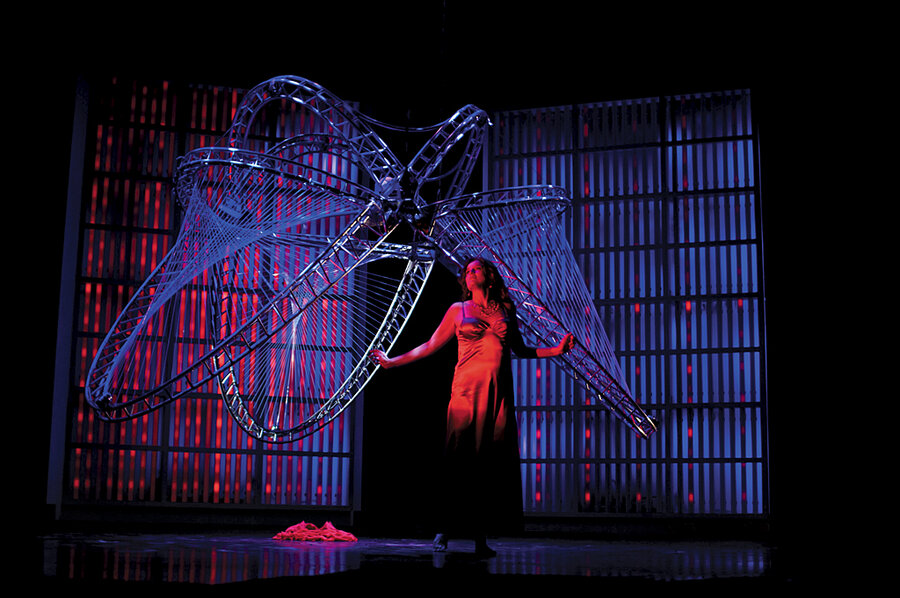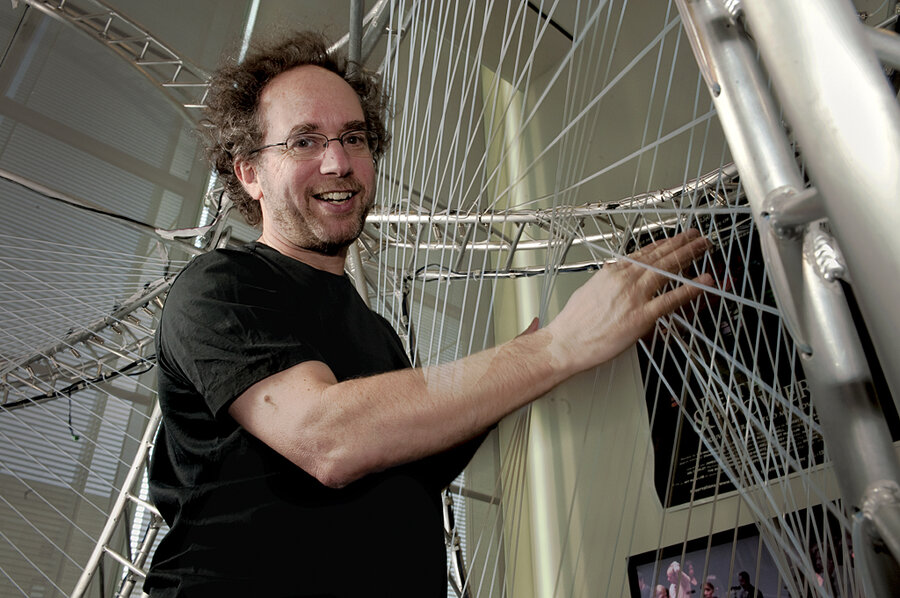A thoroughly modern opera: Robots enter a new frontier
Loading...
| Cambridge, Mass.
The controversial new Broadway show "Spider-Man: Turn Off the Dark," beset by accidents and technical glitches, has pressed the limits of putting technology on stage.
But a new opera comes to the intersection of technology and the performing arts from a different angle: How can we use technology to tell a story about how humans relate to their technology?
"Death and the Powers," which has its North American première March 18 in Boston, fills the stage with nine semi-autonomous "opera bots," as well as huge moving, flashing walls and a chandelier whose strings both seem to speak and respond to touches from a human performer.
But all this technology, some of the most sophisticated to be found on any theatrical stage, is in the service of telling a very human story. The opera's plot centers on an entrepreneur and computer genius, Simon Powers, who has had enough of life in a fleshly form and has decided to download his "self" into "The System," living on in a purely digital form. His third wife, daughter, and adopted son must cope with this startling turn of events. Should they join him in a digital existence?
This familial drama takes place as a play within the play. The opera is set sometime in the future when humans, for reasons left unexplained, no longer exist. But Simon's robots have been charged by him with reenacting a human drama in order to learn more about humans, to gain a grasp of concepts such as death. Temporarily, they transform themselves into human form and enact the drama of the Powers family.
"Is that the meaning of this 'Death' – data rearranged?" asks one robot in the opera's prologue.
"What is suffering? How can I perceive/ What I cannot feel?"
Asks another: "What can we learn? What can we gain,/ From inferior matter?"
Simon responds:
Then you see – it's true!
It isn't the blood,
It isn't the bone.
It's never the matter that matters.
Particles, molecules, cells, fingers, eyes, nerves
Are only places for the system
Of meaningful vibrations.
It's all in the meaning, the movement,
The idea – that's the idea.
The opera, more than a decade in the making, was composed by Tod Machover, who heads the Opera of the Future lab at the Massachusetts Institute of Technology's Media Lab in Cambridge. The libretto is written by Robert Pinsky, a former US poet laureate. Other key contributors include Diane Paulus, the artistic director of the American Repertory Theater in Cambridge, and her husband, writer and producer Randy Weiner. Alex McDowell, the production designer, who establish the futuristic look of the production, has designed such films as "Minority Report," with its gadgetry, and the comic-book fantasy "Watchmen."
"I think what's exciting about this opera is the meditation on technology," says Ms. Paulus, who directs the production. "The subject matter itself is about how technology is part of our lives, and therefore there is actual technology in the show.... But it's actually a very poignant story about a family."
After a brief prologue, Simon enters The System – and the technological wizardry really takes off, both on stage and off.
As Simon, American baritone James Maddalena (whose credits include originating the title role in the opera "Nixon in China") leaves the stage for a soundproof booth located in the orchestra pit. There he is fitted with sensors that allow him to give what composer Professor Machover calls a "disembodied" performance.
Mr. Maddalena's singing voice, arm movements, arm muscle tension, and breathing rate (via a flexible band around his chest) are captured. This information helps control the onstage movements and lights of three walls, each weighing three tons, that display flashing light patterns, as well as a huge chandelier, all of which are now inhabited by the "essence" of Simon. The stage itself "comes alive" as a character, Machover says.
Machover, who received his musical training at The Juilliard School in New York, combines a live orchestra of 15 human musicians with musical sounds made electronically.
"I've always been intrigued by how to [use] all the wonderful things that technology can do to make delicate, complex, layered sound," he says in a recent interview in his airy office on the fourth floor of the exotic-looking, glass-clad Media Lab building on the MIT campus. "I think of electronics as all the sounds that don't exist in a normal orchestra." He sometimes uses these additional sounds "as glue" between more conventional musical moments, he says.
A sophisticated surround-sound system, created by Machover and his team, many of them students, can put the audience in the middle of the action. When Simon sings from inside The System or his wife goes beneath the chandelier to strum its wires and commune with her disembodied husband, the sounds extend to envelop the audience, making it feel as though it, too, is inside The System, Machover says.
Another loudspeaker system across the front of the stage allows sounds to seem as though they are coming from particular spots on stage. "We do a lot of tech tricks to make the sound very natural," Machover says.
Although in some ways the music is unconventional, he's given it a familiar element: strong, clear melodies. "One of the things I do best is write melodies," he says.
The music "has a texture that is quite powerful and has incredible lyricism, almost a kind of Benjamin Brittenesque power to it," Paulus says. It's not "atonal and alienating. It's not at all like that," she says. "It's challenging, serious music. But it has extreme moments of beauty and melody."
Machover, who has played the cello since childhood, says he "hated" opera growing up, preferring rock or other classical music. But as an adult he found his tastes changing.
"My music has always told stories," he says. His aim is to never lose his audience, whom he likes to think of as a group of people on a white-water rafting trip. "You have a guide, and you know you're not going to fall out," he says. "You're going down this [river] which is kind of crazy, but you're secure and you know where you are."
Machover sought out Mr. Pinsky, who teaches at nearby Boston University, to write the libretto, which is written in verse. Pinsky says he would nearly always write the words first, which Machover would then set to music.
"The plot came partly out of my love of science fiction when I was a kid," Pinsky says. He also found intriguing links between poetry and a story that featured robot per-formers (designed and built by Machover's students at MIT). "Robot means 'a thing that works,' " Pinsky says. "In a sense every poem is a robot.... [Poet] William Carlos Williams said a poem is a machine made out of words."
Marc Scorca, president and chief executive officer of Opera America, whose membership includes more than 100 professional opera companies in the United States, saw "Death and the Powers" when it held its world première at the Salle Garnier opera house in Monaco in September 2010.
No other opera he can think of has taken on the subject of the effects of technology on humanity as deeply, Mr. Scorca says. "I think of Philip Glass's 'The Voyage' at the Metropolitan Opera 15 years ago, but [that was] to a lesser extent."
"Death and the Powers" moves opera toward "integrating technology into live opera performance in interesting ways," Scorca says. "It continues to push the boundaries of what is being done on the opera stage."
Machover, who has written several previous operas, sees more innovation ahead. "I've probably pushed the boundaries of different kinds of opera, for better or worse, more than anyone," he says with a smile. "I've tried a lot of things. And this won't be the last."
"Death and the Powers: The Robots' Opera" makes its North American debut at the Cutler Majestic Theatre in Boston March 18, 20, 22, and 25, presented by the American Repertory Theater. It then travels to the Harris Theater in Chicago April 2–10, presented by the Chicago Opera Theater.







